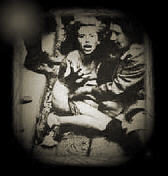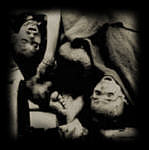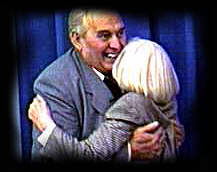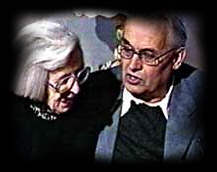







Julian Bilecki was just a skinny teenager when he and his family hid 23 Jews in an underground bunker, saving them from Nazi death squads in war-torn Poland. In 1943, nearly all the families of the Jewish community in Podhajce, Eastern Galicia, about 3,000 Jews, were slaughtered by the Nazis. A little group - several of them children and teenagers - escaped from the Ghetto and survived the Nazi extermination finding their way to the Bilecki farm.
In June of 1943 the Bilecki family members who lived near the ghetto heard a knock on their door, opened it and saw not only some of their Jewish friends and neighbors but also some strange faces - 23 in all. They had come to seek refuge from the Nazis.
The Bilecki family took them in and decided that with the few young, strong men in the group of escapees they would build a bunker in a cave in the woods and camouflage it with leaves and branches. The biggest problem was providing food. Food for the villagers was scarce during these times, but how do you feed 23 extra people without arousing suspicion? Somehow the Bileckis were able to ration enough food for everyone.


However, this temporary shelter was soon discovered by passers-by in the woods and, fearing for their friends' lives, the Bileckis were forced to look for another location, to build another bunker. The second bunker was built very near to the Bileckis' own home. It was winter and the snowcovered ground would leave a trail of footsteps to the new hiding place. A survivor, Mrs. Grau Schnitzer, later recalled how Julian Bilecki being a young, agile and very brave boy, would jump from tree to tree to deliver his bounty to his Jewish friends in order to avoid leaving tracks in the snow.
The Bileckis showed the desperate Jews where to hide, helped them move when they were almost detected and brought burlap sacks of food - mostly potatoes, beans and corn meal food - and clothes regularly for a year. Once a week, someone from the family would come to sing hymns to the Jews and share news from the outside world. "They gave us food for the soul - hope to survive," Schnitzer said. "They deprived themselves. They endangered their lives."
Mrs. Grau Schnitzer, then 9, recalled how she left the ghetto with her parents to bury a wagon full of dead bodies and then escaped. Her father and uncle, who had known the Bileckis before the war, went to them for help."We knew that they were believers and we knew that they were good people," she recalled. "We had no choice, and we hoped that they would not report us. We said Here we are, help us and they helped us".
Another survivor, Sima Weissman, later recalled, how they "not only hid us, but spent time with us, reading the Bible and praying for our salvation .. three times it was necessary to change hiding places, so that nearby villagers would suspect nothing. It's impossible to describe what these people did for us. No family member would have done more than they did."



Genia Melzer, another survivor, was 17 then and was left for dead by the Nazis in a pile of corpses after a mass shooting. "I lay down on the floor with my head down, and my little cousin, 9 years old, lay down on my right side. They started shooting, but I wasn't shot. They thought I was dead but when a little girl coughed, they came with an ax and started chopping." Genia survived the second assault, too, still pretending to be dead. "They took us to this mass grave and they threw all the people into it and I was on top."
Genia Melzer crawled out from among the bodies and ran to the woods near Podhajce, where Julian Bilecki found her covered with blood and took her in. Her brother, uncles, aunts, cousins and all her friends were killed - but she survived. Today she is a greatgrandmother ...
After almost a year of living underground, one day the group heard shots above the bunker. They knew that at last they had been liberated and freedom was just beyond that thin layer of twigs and branches that had concealed their existence from the world for almost a year. The Russian Army liberated the area on March 27, 1944, and the surviving Jews went their separate ways, some immigrating to the U.S.
Over the years, many survivors sent packages of food and clothing to the Bilecki family, who remained poor, and corresponded by mail. There are no telephones on poor Ukrainian farms. They regularly send money to the Ukrainians. And they arranged for all the rescuers to be honored as Righteous Gentiles by Yad Vashem in Jerusalem.
More than a half-century later, a gray-haired Julian Bilecki, now 70, and five survivors, all New York residents, were brought together by the Jewish Foundation for the Righteous. A retired bus driver Bilecki was flown in from Ukraine, his first airplane ride, first time out of his country. As he walked into a reception room at Kennedy Airport, the five survivors, now gray and some walking with canes, applauded and cried as they greeted with flowers, hugged and kissed the man who, as a teenager, risked his life to help them escape the Nazis and survive the Holocaust.


Julian Bilecki and 'his' Jews
Tears welled up into his eyes. "I see you all have gray hair," Bilecki said through a translator. "I too have gray hair. I thought I would never see you again. I feel lost. I thought this would never happen. All I did was help. It is very pleasant that people remember. Now I am getting paid back by God."
"If it wasn't for them, we would not be here right now. As Jews, we had no right to live. When Jews were in need, these people were there for us," one survivor said ...
In 1992, in the first ceremony of its kind in Ukraine, seven Ukrainian citizens were inducted into Yad Vashem's Righteous Among the Nations for their efforts to save Jews during the Holocaust. One of those honored was Julian Bilecki. Attending were representatives of Ukrainian President Leonid Kravchuk, the Ukrainian Ministry of Foreign Affairs and the Ukrainian Orthodox Church.
Julian's brother Roman, a
resident of upstate New York, had been similarly honored for his heroic efforts
to offer refuge to Jews by several organizations.
sources:
The Shawnee News Star
The Ukrainian Weekly
The Jewish Week
Newsday
CNN
AP
www.auschwitz.dk
www.oskarschindler.com
www.shoah.dk
© 2007-2009 Louis Bülow. All Rights Reserved.